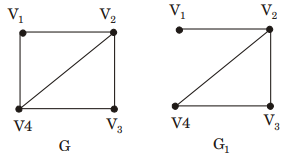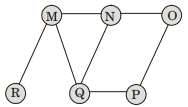Data Structures and Algorithms - Graph Algorithm
- Option : C
- Explanation : d(r, v) and d(r, v) will be equal when u and v are at same level, otherwise d (r, v) will be less than d(r, v)
- Option : C
- Explanation : Applying BFS Algorithms
Starting from Q
Queue Q
Making Q’s child’s status 1.
Queue
Q| M| N| P
Making M’s child 1 (which are not 1)
Q| M| N| P| R Making N’s Child 1 Q| M| N| P| R| O (other are already 1)Status Q M N O P R 2 1 1 1 2 2 1 1 1 2 2 2 1 1 1
- Option : B
- Explanation : Suppose G = (v, E) and G1 = (v, E1) such that
E1 ≤ E and v1 ≤ v
Consider an example
 Consider the w(e) = 1 of e ∉ E1
it means the cost
of v1
to v4
is only 1 other edges having cost 0. It is
noted that G1
is connected (As shown in example).
Consider the w(e) = 1 of e ∉ E1
it means the cost
of v1
to v4
is only 1 other edges having cost 0. It is
noted that G1
is connected (As shown in example).
- Option : D
- Explanation : for i = 1 ton for j = 1 ton for K = 1 ton A[j, K] = max (j, K], A[j, i) + a(i, K)] Anxn Matrix and A[j, K] = 1 if (j, K) ∈ E so there exist a path from J to K and must contain A[j, K] edges





